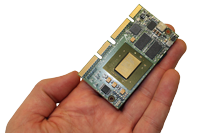PLDA ultra-compact System-on-Module Enables Lighthouse Imaging to Speed Up Design Turn-around for Image Acquisition and Processing
SAN JOSE, CA – December 15, 2014 – Lighthouse Imaging, which provides all-inclusive design and manufacturing services for medical imaging and visualization, is using PLDA’s SoMZ-7045 platform to create commercial products for their clients in record time. PLDA designs and sells intellectual property (IP) cores,prototyping tools and system-on-module components. SoMZ is a highly-integrated system-on-module based on the Xilinx Zynq-7045 All Programmable system-on-chip (SoC).

Featuring an ARM® dual-core Cortex®-A9 MPCore and up to 350K of advanced low-power FPGA logic cells, the SoMZ platform combines the flexibility and ease of programming of a CPU with the configurability and parallel processing power of an FPGA. The SoMZ platform features:
- Ultra-compact form factor, at only 3” x 1.6”, ideal for area-constrained applications.
- Careful board layout, which enables superior signal integrity, and support for multi-gigabit serial protocols, including PCIe Gen2 and 10G Ethernet.
- A starter kit – including carrier boards and SoMZ – available for quick prototyping and application testing.
- Comprehensive reference designs, provided with source code, to enable a seamless out-of-the-box experience.
- Standard Linux Debian support, which allows rapid deployment of existing application software.
“Lighthouse Imaging delivers world-class engineering design services, including optical, mechanical, electrical and software development. Our image acquisition and processing capabilities, as well as overall design time, have been greatly bolstered by the availability, compactness, and feature set of the PLDA SoMZ platform,” said Benjamin Gray, Director of Research and Development at Lighthouse. “PLDA has allowed us to convert client wish lists to commercial products in record time.”
“Our SoMZ platform provides great performance on a small form factor,” said Stéphane Hauradou, CTO at PLDA. “We pride ourselves in providing highly capable products at a competitive price, all backed by first-class customer service. It’s a pleasure to be able to help an award-winning company like Lighthouse Imaging reach their product goals.”
About PLDA Group
PLDA designs and sells intellectual property (IP) cores and prototyping tools for ASICs and FPGAs that aim to accelerate time to market for embedded electronic designers. The company specializes in high-speed interface protocols and technologies such as PCIe and Ethernet. PLDA provides IP cores with a complete set of tools, including FPGA production-ready and prototyping cards, system-on-module components, drivers, APIs and testbenches. These products benefit from a global support and sales organization able to sustain over 5,800 ASIC and FPGA customers worldwide. PLDA is a global company with offices in North America (San Jose, California) and in Europe (France, Italy, Bulgaria).
Related Semiconductor IP
- HBM4 PHY IP
- Ultra-Low-Power LPDDR3/LPDDR2/DDR3L Combo Subsystem
- MIPI D-PHY and FPD-Link (LVDS) Combinational Transmitter for TSMC 22nm ULP
- VIP for Compute Express Link (CXL)
- HBM4 Controller IP
Related News
- Gidel introduces groundbreaking edge computer with NVIDIA Jetson Orin NX system-on-module and high-bandwidth camera frame grabber for real-time image acquisition compute and AI processing
- PLDA and ReFLEX CES announce new line of System-on-Module (SoM) products, combining the ease of programming of a CPU with the configurability of an FPGA
- PLDA announces the availability of a new System-on-Module product, the PLDA SoMZ-7045
- Image Matters and PLDA enables 8K, HDR, HFR and IP transport video system design with new levels of modularity, flexibility and performance.
Latest News
- Tenstorrent unveiled its first-generation compact AI accelerator device designed in partnership with Razer™ today at CES 2026
- Marvell to Acquire XConn Technologies, Expanding Leadership in AI Data Center Connectivity
- Creonic Releases Updated SDA OCT IP Core Supporting OCT 4.0 and Enhanced Synchronization
- Synopsys Showcases Vision For AI-Driven, Software-Defined Automotive Engineering at CES 2026
- Ceva Delivers Real-Time AI Acceleration on NXP’s Processors for Software-Defined Vehicles